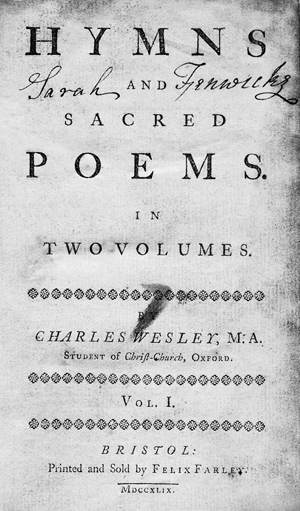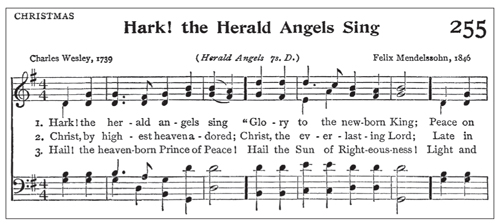Why was the Partridge in the Pear Tree? (9 page)
Read Why was the Partridge in the Pear Tree? Online
Authors: Mark Lawson-Jones

St Austin.
It is suggested in
The Oxford Book of Carols
by Dearmer, Vaughan Williams and Shaw (1928) that the holly and the ivy represents the battle of the sexes, with holly having masculine qualities, and ivy feminine. The imagery could have been part of a tribal tale that developed into a dance for young men and women.
One old legend also states that holly sprang up under the footsteps of Jesus when he walked the earth to the cross and says that merely holding it brought good luck. Therefore, in old church calendars it also documented that the churches on Christmas Eve were decked (
temple exornate
) with holly.
In 1630, with the Stuarts overthrown, the Puritans banned many things associated with Christmas, not just carols, but also holly and ivy as seasonal decoration. With the Restoration, however, these things returned with added vigour. During this period, Edward Fisher refuted the Puritanical war on Christmas by publishing a point-by-point guide to celebrating Christmas in his book The
Feast of Feasts
(1649). In it he says that the season of Christmas is designed:
… to eat mince pies, plum-pottage or brawn in December, to trim churches or private houses with holly and ivy about Christmas, to stick roasting pieces of beef with rosemary or to stick a sprig of rosemary in a collar of brawn, to play cards or bowls, to hawk or hunt, to give money to the servants or apprentices box, or to send a couple of capons or any other presents to a friend in the twelve days.
These, and other texts, undoubtedly helped to secure the place of holly and ivy in the celebration of Christmas. A Victorian merchant in 1851 claimed that he sold 250,000 bushels of holly during the Christmas season, that’s how popular it was!
So where did the carol ‘The Holly and the Ivy’ come from? ‘The Sans Day Carol’ (Saint Day’s Carol), one of the many Cornish carols written in the nineteenth century, also provides a link. St Day was a Breton saint, and the ‘Sans Day Carol’ was transcribed from the singing of Thomas Beard, a villager in St Day, in the parish of Gwennap, Cornwall. The fourth verse is a translation from the Cornish version ‘Ma gron war’n gelln’:
Now the Holly bears a berry as white as the milk
And Mary bore Jesus, who was wrapped up in silk.
Chorus
And Mary bore Jesus Christ our Saviour to be
And the first tree in the greenwood, it was the holly.
Holly, holly,
And the first tree in the greenwood it was the holly.
Now the Holly bears a berry as green as the grass
And Mary bore Jesus, who died on the cross.
Now the Holly bears a berry as black as the coal
And Mary bore Jesus, who died for us all.
Now the Holly bears a berry as blood is it red
Then trust we our Saviour who rose from the dead.
This link clearly shows the ongoing importance of the imagery of holly and ivy in the Christmas season.
So, what about the carol? ‘The Holly and the Ivy’ itself probably dates back to the seventeenth century and was revamped around 150 years later by the famous folk music expert Cecil J. Sharp to be included in his collection of songs, hymns and carols of 1911. A choral arrangement was written by Sir Henry Walford Davies, which remains one most common musical arrangements we hear at Christmas. The original tune however was described as an ‘Old French tune’. In the book
Early English Lyrics
by Chambers and Sidgwick (1926), there is mention of a broadside printed in Birmingham in 1710 with a version of the carol, which begins:
The holly and the ivy
Now are both well grown
Of all the trees that are in the wood
The holly bears the crown
The book
The Oxford Book of Carols
(1928) says of the carol, ‘Words and melody taken from Mrs. Clayton at Chipping Camden, Glos. (Supplemented by words from Mrs Wyatt, East Harptree, Somerset)’.
In the twenty-first century it is pleasing to see that people still hold on to the tradition of placing holly and ivy in their homes. Whether it is done to celebrate the birth of Jesus Christ, the baptism of thousands by St Austin, to resurrect the midwinter festival of Saturnalia, to ward off evil spirits or to think of the battle of the sexes, it is certainly a most rich and complex tradition that still continues to this day. And the carol, ‘The Holly and the Ivy’, still echoes through the land, indeed throughout the world.

Hark! the Herald Angels Sing
Hark! the herald angels sing
‘Glory to the newborn King!’
Peace on earth and mercy mild
God and sinners reconciled
Joyful, all ye nations rise
Join the triumph of the skies
With the angelic host proclaim:
‘Christ is born in Bethlehem’
Hark! the herald angels sing
‘Glory to the newborn King!’
Christ by highest heav’n adored
Christ the everlasting Lord!
Late in time behold Him come
Offspring of a Virgin’s womb
Veiled in flesh the Godhead see
Hail the incarnate Deity
Pleased as man with man to dwell
Jesus, our Emmanuel
Hark! the herald angels sing
‘Glory to the newborn King!’
Hail the heav’n-born Prince of Peace!
Hail the Son of Righteousness!
Light and life to all He brings
Ris’n with healing in His wings
Mild He lays His glory by
Born that man no more may die
Born to raise the sons of earth
Born to give them second birth
Hark! the herald angels sing
‘Glory to the newborn King!’
Charles Wesley was probably the most prolific hymn writer Britain has ever produced and this hymn is one of his most famous compositions.
Wesley was born on the 17 December 1707, in Epworth, Lincolnshire, the eighteenth and last child born to Samuel and Susanna Wesley. He was educated in Westminster College, leaving with a scholarship to study in Christ College, Oxford. Whilst there he and his brother John formed the ‘Oxford Holy Club’ for the purposes of Christian worship, but also to organise visits to the sick and imprisoned. Soon, the group became known as ‘Methodists’.
Wesley eventually became a college tutor; however, he left to be ordained as a deacon in the Church of England in 1735. Following a disastrous move to the new colony of Georgia, where he intended to work as a missionary, but became the secretary to the governor, he returned to London emotionally exhausted.
In 1738, Charles suffered serious illness and whilst recuperating met members of the Moravian Church in London. The Moravians, closely linked to the protestant Lutherans, had begun in 1730 after a time of division and uncertainty and were hoping to put down the foundations of a new church. Their evangelical zeal and concern for others inspired Wesley to re-evaluate his own life. The day after their first meeting, Whitsunday, 21 May 1738, he wrote his first hymn, ‘Where Shall My Wondering Spirit Begin’. This was to be the first of over 6,000 hymns he penned.
Later that year, Christmas Day 1738, Charles Wesley preached at St Mary’s Church in Islington, he also administered the chalice at Holy Communion. The next day his close friend George Whitefield said, ‘We had the sacrament this and the following four days, the whole week was a festival indeed; a joyful season, holy unto the Lord’.
Stories tend to suggest that Wesley heard the sound of the bells ringing on his way to church on Christmas Day, filling him with deep happiness and enthusiasm to pen the hymn ‘Hark! The Herald Angels Sing’. There is no evidence that this is the case, however it may well be true. The real question is whether this Christmas Day in 1738 was the first to be celebrated with the singing of ‘Hark! The Herald Angels Sing’ in its original form? It is certainly possible, as a few months later the hymn was published in the book
Hymns and Sacred Songs
, which Charles Wesley wrote with his brother John. In the following years his old friend George Whitefield shaped it into its present lyrical form.
In 1753, Whitefield altered the first line of the hymn from ‘Hark how all the welkin rings’ to ‘Hark! The Herald Angels Sing’, which although an improvement, must have irritated Wesley, who believed that heaven (the meaning of ‘welkin’) rang with joy, maybe like the bells he reportedly heard on Christmas Day.
Another difficulty for Wesley would have been that as a keen biblical scholar he would have understood that the ‘Angel’ and the ‘Multitude of the Heavenly Host’ in the Bible were not singing at all, they were ‘
Saying
, Glory to God in the highest’ (Luke 2:13-14).

The title page of Wesley’s
Hymns and Sacred Poems.
Quite how much this would have been a problem to Wesley we can only guess, although if he were to have seen the future and the countless thousands of Christmas cards that show singing cherubic angels he might have complained. Both John and Charles Wesley felt strongly that the people should be educated in theological issues to properly understand their faith. Charles used the words of the hymns to explain theology to people who might well be unable to read or write.
Early eighteenth-century Britain was free from the rebellious atmosphere that prevailed in the seventeenth century and the Industrial Revolution was yet to start. The country was becoming wealthier through trade and Robert Walpole, the first Prime Minister, had chosen a ‘cabinet’ for the first time. He discouraged the Church from being active, so that it would not prove troublesome to the Government.
The Church had entered a period of inaction and neglect. Daily services were discontinued in many places and the poor weren’t cared for. Even though the Church remained popular amongst the people, the clergy were considered lazy and were held in contempt. Promotion was dependent on political affiliation and the church was ignored by the state that considered the churches only role to be to support the Government.
The story of this hymn is the soundtrack to the mission of John and Charles Wesley to reinvigorate the Church. Just as John’s preaching would awaken much religious feeling, especially among the lower classes, the words of Charles’ hymns would encourage people. As ‘Methodism’ spread, Charles wished to remain within the broad structures of the Anglican Church; he had never intended his work to be separate.
Even though Wesley had been reinvigorated with evangelical fervour, he was known as a sombre man, who would request slow and reflective musical compositions for his work. ‘Hark the Herald’ would have been sung to a completely different tune than the one we know and love today, probably the tune to ‘Christ the Lord is Risen Today’, another hymn written by him.
The most familiar tune for this hymn since the mid-nineteenth century is called Festgesang, composed by Felix Mendelssohn in 1840 as a cantata to commemorate the 300th anniversary of Gutenberg’s invention of the printing press. Sixty-seven years after the death of Charles Wesley in 1855 the English musician William Cummings made changes so that it would fit the words of the hymn. Mendelssohn would have been as shocked as Wesley at the use of his music, the composer once said the music would ‘never work with sacred tunes’.

